|
It is a beutiful sunny and warm October day in 2001 - an unsually sunny
and warm October in Europe this year. Come visit Venice with
us. Discover this unique city built on oak piles in the lagoon.
here, many things are different - there are no streets, but many channels.
There are virtually no modern buildings and, with the exception of the
ugly area around the parking garages at Tronchetto and Piazzale Roma, the
city has not changed much since many centuries. In Venice, there
are no cars or even bicycles: just boats and pedestrians.
The old historical center of
the city is situated four kilometres from the mainland, on 118 islands
of the Venetian Lagoon. 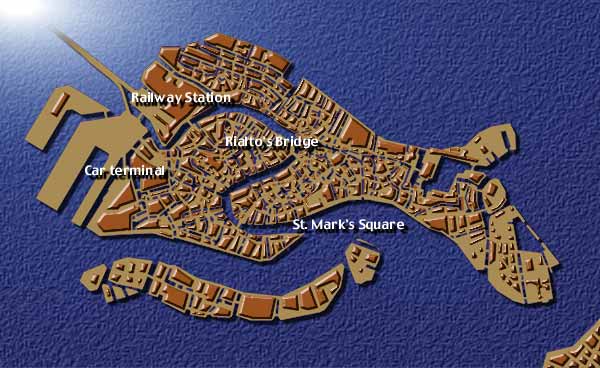 (This is The Venice: the 19th and 20th century expansion on the
mainland has no character in comparison.) Venice is criss-crossed
by more than 150 canals and 400 bridges, and is divided into 6 districts
known as 'sestieri' (San Marco, Castello Cannaregio, Santa Croce,
San Polo, Dorsoduro). Characteristic buildings look onto hundreds
of small squares (campi and campielli) linked by narrow streets
called calli. The municipal territory also includes the mainland
areas of Mestre and Porto Marghera connected to the lagoon
city by road and rail bridges. The lagoon centres of Burano, Murano,
Lido, Cavallino, Malamocco, San Michele and Torcello are also
administrated by Venice.
(This is The Venice: the 19th and 20th century expansion on the
mainland has no character in comparison.) Venice is criss-crossed
by more than 150 canals and 400 bridges, and is divided into 6 districts
known as 'sestieri' (San Marco, Castello Cannaregio, Santa Croce,
San Polo, Dorsoduro). Characteristic buildings look onto hundreds
of small squares (campi and campielli) linked by narrow streets
called calli. The municipal territory also includes the mainland
areas of Mestre and Porto Marghera connected to the lagoon
city by road and rail bridges. The lagoon centres of Burano, Murano,
Lido, Cavallino, Malamocco, San Michele and Torcello are also
administrated by Venice.
Early historical information
on Venice dates back to the fifth and sixth centuries when, to escape the
Barbarian invasions, refugees from the Venetian countryside took shelter
in the Lagoon. At first, they were ruled by Maritime Tribunes then
by the Doges (the first was Paolo Lucio Anafesto, in 697), gradually
eluding Byzantine influence, partly as a result of the initiative of the
inhabitants, who transformed it into an important trading centre for shipping
in the Mediterranean and towards the Orient. Its importance increased during
the Crusades, when it extended its rule over the Aegean islands, Peleponesia,
Crete and part of Constantinople. Rivalry with Genoa and the other Italian
maritime republics served only to
increase its strength which reached its peak in
the fifteenth century.
In the same period, Venice increased
its territories on the Venetian mainland, occupying Treviso, Padua, Vicenza
and later Verona, Feltre, Belluno and Bassano (1404-1405), until in 1454,
its boundaries stretched to the Adda river to the west,
and into Friuli to the east. The fall of Constantinople,
however, and the discovery of America, marked the beginning of commercial
and political decline for the Republic of Venice, culminating in the loss
of independence ratified by the Treaty of Campoformio (1797), which gave
Venice to Austria. After the Napoleonic period (1805-14) and the heroic
events of
the Risorgimento (1848 uprising against the Austrians
under the leadership of Daniele Manin) it was finally reunited with the
Kingdom of Italy in 1866, following the Third War of Independence.
 It is a very difficult task to squeeze in a few lines the countless attractions
that make Venice one of the world's most famous tourist cities. So here
are a few - those that must absolutely not be ignored. First and foremost,
Piazza
San Marco, the traditional postcard scene of Venice with its famous
cafés and surrounded by beautiful Renaissance buildings, with the
Basilica of the same name, of Byzantine inspiration, (11th-15th century)
overlooking the whole square. Nearby is Palazzo Ducale (14th-15th
century), a typical example of Gothic-Venetian architecture, housing works
by famous artists. By taking a boat on the Grand Canal, you admire the
many noble Gothic-Venetian buildings overlooking the waters:
Cà
Foscari, Palazzo Giustinian, Palazzo Cornèr (Cà Grande),
Palazzo Grimani, Palazzo Vendramin Calergi, the very famous
Cà
d'Oro and many others. The churches include Santa Maria Gloriosa
dei Frari (13th-14th century) housing works by Titian and Giambellino,
S. Zanipolo, Santa Maria dei Miracoli (Renaissance),
Santa Maria
della Salute (17th century) with paintings by Titian and Tintoretto,
San
Giorgio Maggiore (17th century). The campi (the small squares)
are of great environmental and artistic interest, always surrounded by
buildings or churches worthy of a visit. Among others are Campo S. Moisè,
S. Bartolomeo, S. Cassiano, S. Maria Mater Domini, S. Polo, S. Zulian,
Saints Giovanni and Paolo (monument to Bartolomeo Colleoni). Lastly,
you must not fail to take a trip under the famous Ponte di Rialto
and the even more famous Ponte dei Sospiri (Bridge of Sighs).
It is a very difficult task to squeeze in a few lines the countless attractions
that make Venice one of the world's most famous tourist cities. So here
are a few - those that must absolutely not be ignored. First and foremost,
Piazza
San Marco, the traditional postcard scene of Venice with its famous
cafés and surrounded by beautiful Renaissance buildings, with the
Basilica of the same name, of Byzantine inspiration, (11th-15th century)
overlooking the whole square. Nearby is Palazzo Ducale (14th-15th
century), a typical example of Gothic-Venetian architecture, housing works
by famous artists. By taking a boat on the Grand Canal, you admire the
many noble Gothic-Venetian buildings overlooking the waters:
Cà
Foscari, Palazzo Giustinian, Palazzo Cornèr (Cà Grande),
Palazzo Grimani, Palazzo Vendramin Calergi, the very famous
Cà
d'Oro and many others. The churches include Santa Maria Gloriosa
dei Frari (13th-14th century) housing works by Titian and Giambellino,
S. Zanipolo, Santa Maria dei Miracoli (Renaissance),
Santa Maria
della Salute (17th century) with paintings by Titian and Tintoretto,
San
Giorgio Maggiore (17th century). The campi (the small squares)
are of great environmental and artistic interest, always surrounded by
buildings or churches worthy of a visit. Among others are Campo S. Moisè,
S. Bartolomeo, S. Cassiano, S. Maria Mater Domini, S. Polo, S. Zulian,
Saints Giovanni and Paolo (monument to Bartolomeo Colleoni). Lastly,
you must not fail to take a trip under the famous Ponte di Rialto
and the even more famous Ponte dei Sospiri (Bridge of Sighs).
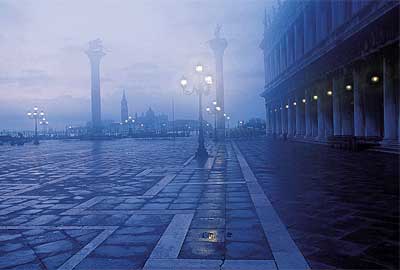 So here we are in Venice - we have the choice to take a public water-bus
- a vaporetto - or a taxi - motorboat - to drive along the Canale
Grande - the main 'street'- passing all these fairy-tale palazzi.
So here we are in Venice - we have the choice to take a public water-bus
- a vaporetto - or a taxi - motorboat - to drive along the Canale
Grande - the main 'street'- passing all these fairy-tale palazzi.
Early in the morning, the city
still sleeping, wait for the sunrise on
Piazza San Marco, the main
square, watch the beautiful setting of the the Basilica, the palace of
the Doges, all the surrounding buildings and the waterfront with gondolas
waiting for the first tourists. Slowly the sun is rising and Venice comes
alive. A small bakery opens with warm croissants and cappuccino.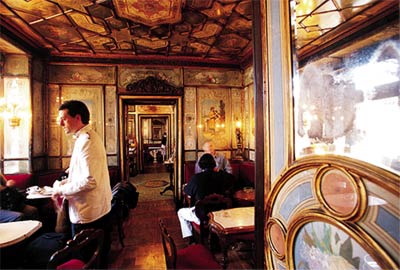
Start walking through the mazeof
narrow streets across stone bridges, without a map - enjoying getting lost
and discovering what square with a magificent pallace or cathedral will
lurk behind the next corner . There are yellow signs indicating the
general directions, just in case you do get really lost. But it really
does not matter - there is so much to discover: photographer's heaven.
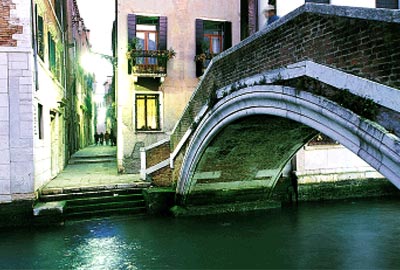 One
day is not enough. One has to get into the Venice-mood: forget the
outisde world, the industrial parks on the mainland, the ugly entrance
the to historical center. Here, there is seemingly no hurry, no cars,
no parking meters to obey - just fabulous food, good wine, Vivaldi, and
all sorts of architectural corners providing endless scenes for the occassional
photographer. One
day is not enough. One has to get into the Venice-mood: forget the
outisde world, the industrial parks on the mainland, the ugly entrance
the to historical center. Here, there is seemingly no hurry, no cars,
no parking meters to obey - just fabulous food, good wine, Vivaldi, and
all sorts of architectural corners providing endless scenes for the occassional
photographer.
There are cops in Venice. They
seem to worry primarily about the tie being straight and the Armani-esque
dark-blue uniforms nicely pressed. We wondered if - in the total
absence of doughnut shops - they gather at Florian's at Piazza del Marco
and drink espressi. We remember seeing them making an arrest:
a rose vendor on Piazza del Marco, being escorted away for some
reason or other; two young cops - a man and a woman - leading the
"perp" away, gently holding his elbow, like a maitre d' leading
a guest to a table at Antoine's. This is Venice-mood.
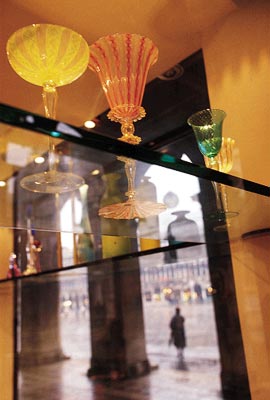 Take
a trip on a water bus to the neighboring island of Murano. Passing
a large cemetary with above-ground tombs, you realize that Venice - due
to its sea-level location - has a lot it common with New Orleans.
Next, visit the glass-blowing factories and discover that the very first
one, immediately next to the vaporetto stop is owned by a family
with New Orleans ties. We met Giancarlo, one of the owners, and foundout
that, having been in the glass business in Murano for 600 years, the family
has trong New Orleans ties: a Nawlins-native wife, children born
at Touro hospital: we get talked easily into doing business with Giancarlo
and impuls-buy and chandellier... This is Venice-mood, too. Take
a trip on a water bus to the neighboring island of Murano. Passing
a large cemetary with above-ground tombs, you realize that Venice - due
to its sea-level location - has a lot it common with New Orleans.
Next, visit the glass-blowing factories and discover that the very first
one, immediately next to the vaporetto stop is owned by a family
with New Orleans ties. We met Giancarlo, one of the owners, and foundout
that, having been in the glass business in Murano for 600 years, the family
has trong New Orleans ties: a Nawlins-native wife, children born
at Touro hospital: we get talked easily into doing business with Giancarlo
and impuls-buy and chandellier... This is Venice-mood, too.
And then you leave, and return
to the real world: on a water-bus or taxi on the Grand Canal, or - after
a few days navigating the narrow alleys of Venice like a native - back
to your car at the parking garage. Cross the causeway onto the mainland,
dive into the heavy traffic on the A-4 Autostrada from Milan
to Udine and Klagenfurt, and Venice seems like a distant dream.
Here is a summary of the places one should see while
in Venice:
Basilica di San Marco
One of the most precious Christian
relics, the body of St. Mark, was recovered by a miracle and, buried beneath
the Basilica di San Marco. The church is a gem of Venice and a symbol of
the power and wealth that Venice once attained. The outside is elaborately
decorated with beautiful marble and amazing mosaics, including one from
the 13th century. Inside there are an endless amount of mosaics on the
walls and ceiling, which help to dim the natural light to create a mysterious,
exotic atmosphere. Also inside is the Pala d'Oro which should not be missed,
as the 10th-century golden alterpiece is embellished with nearly 2000 precious
gems and 255 enameled panels.
Palazzo Ducale
The Doges Palace served as the
official Venetian residence of the Doges, who were the elected officials
of the former Venetian Republic. This splendid, Gothic-style palace was
a showplace for the artistry, architecture and craftmanship of the day.
In addition to living quarters, the palace contained offices, meeting rooms,
law courts and its infamous prison cells, which are connected to the palace
by the Bridge of Sighs.
Canal Grande
Illustrating the uniqueness
of Venice, this great 'road of water' is the most beautiful street in Venice.
One can glide along the Grand Canal and be surrounded by the most opulent
architecture. The atmosphere is absolutely unforgettable, as the splendour
of the Grand Canal is unparalleled. To meander along the canal by gondola
is literally to take a journey through Venetian history.
Galleria Dell' Accademia
This amazing gallery contains
the finest collection of Venetian art. You can see renowned works, such
as 'Pieta' by Titian, 'The Tempest' by Giorgione, Veronese's 'Christ in
the House of Levi', and Bellini's 'Madonna Enthroned'. 24 separate rooms
house works by all the great Venetian artists.
Ponte di Rialto
Arched high over the Grand Canal,
Ponte di Rialto is the most famous of the city's bridges. Built severn
times, today's bridge was constructed by Antonio di Ponte in 1591. It is
in the centre of the city's old trading area and trades such as wine, coal
and iron are still reflected in the nearby street names. To this day, shops
are strung along this famous bridge, selling jewellery, linens and Murano
glass.
Chiesa dei Frari
Due to the size and style of
this massive church, Frari is often compared with the Church of San Giovanni
e Paolo. The architecture displays fine detail around the plain brickwork,
but due to the sheer size of the building it appears rather rigid and plain,
although nonetheless pleasing to the eye. The outside appearance is reflective
of the Franciscan lifestyle, which focused on spirituality and poverty.
Inside, there are Venetian treasures including the extraordinary Titian
altarpieces and Bellini¹s Madonna and Four Saints.
Scuola di San Giorgio degli Schiavoni
This structure was once a brotherhood
devoted to charitable works. Here, between 1502 and 1507 AD Vittore Carpaccio
painted an exceptionally interesting series of paintings, known as the
Cycle of St. George. Other works of Carpaccio are also displayed, showing
the beautiful colour and vitality ever present in his works. St. George
and the Dragon is a favourite, as the painting demonstrates the romance
and courage of heroic chivalry.
Scuola di San Rocco
This school of painting is richly decorated with Tintoretto¹s
mystically spiritualistic paintings from the 16th century. Tintoretto was
skilled in embodying emotions into his paintings drawn from emotive chapters
in the Bible.
Ca' d' Oro
This Venetian Gothic palace
displays incredible opulence with its elegant Gothic architecture and décor.
The mansion was given the name Ca' d'Oro or House of Gold because the façade
was once gilded, but over time it has suffered from erosion. Through
restoration, the original majestic colours of the façade
reflect in the Grand Canal once again. Ca' d' Oro houses the Franchetti
Gallery, which is dedicated to Venetian Byzantine Art. Among this gallery¹s
fine collection of paintings, sculptures and Flemish tapestries is the
renowned Saint Sebastian by Mantegna.
Campo dei Santi Giovanni e Paolo
Formerly known as the Campo
delle Maravege (marvels), this square is appropriately full of wonderful
sights. The grand sculpture by Verrocchio, Monumento di Bartolomeo Colleoni,
now stands in the square. The infamous John Ruskin praised Verrocchio's
sculpture as 'one of the noblest works in Italy.' Also
the largest church in Venice is located here; the Basilica dei Santi Giovanni
e Paolo.
Santa Maria della Salute
The Ciesa di Santa Maria della
Salute is a famous Venetian landmark, guarding the entrance to the Grand
Canal. After the 1630 plague subsided, this gigantic, white, domed 17thcentury
church was designed by Longhena and officially dedicated to Our Lady of
Good Health. This majestic church demonstrates serenity
and grandeur through its bold Baroque architectural style.
Ca' Rezzonico
This gigantic Baroque mansion
contains the most dazzling ballroom in Venice. Also inside is the Museo
del Settecento Veneziano, which is home to a number of fine pieces from
18th-century Venetian artists, including an admirable series of frescoes
by Tiepolo.¹
Chiesa di San Sebastiano
Rich decoration embellishes
the inside of this 16th-century church where the painter Veronese established
his reputation by painting amazing frescoes whilst still in his twenties.
Veronese continued to produce astounding works within the church, throughout
his
career and was eventually buried here. The opulent nature
of Veronese¹s art beautifies the church and makes it so unique.
Chiesa di San Zaccaria
This is a wonderful church built
in the 15th century and incorporates the former 9th-century church that
was originally on this site. The inside is literally covered with paintings
including Bellini¹s 'Sacra Conversazione' and Tiepolo's 'Flight into
Egypt'.
Sources: Windows
on Italy, Surprise
Talks about Life
Continue your virtual visit on these websites:
Stay at a moderately priced,
small, yet cozy Hotel Galleria on the Grand Canal
(do not plan to hold parties of more than 3 people in your room...)
Enjoy an (overpriced) dinner Ristorante Alla Borsa
A
photogallery of Venice by Invenicetoday.com
A gallery of antique lithographs
at Rareprints.de
The
Living Venice Guide
Visit
The City of Venice just by clicking the Map
Travelholiday
Online
Guide from Veniceworld.com
Guide from V4u.it
How's the weather over there now?

<< back to our Venice 2001
page
Last updated October 28, 2001 |

 It is a very difficult task to squeeze in a few lines the countless attractions
that make Venice one of the world's most famous tourist cities. So here
are a few - those that must absolutely not be ignored. First and foremost,
Piazza
San Marco, the traditional postcard scene of Venice with its famous
cafés and surrounded by beautiful Renaissance buildings, with the
Basilica of the same name, of Byzantine inspiration, (11th-15th century)
overlooking the whole square. Nearby is Palazzo Ducale (14th-15th
century), a typical example of Gothic-Venetian architecture, housing works
by famous artists. By taking a boat on the Grand Canal, you admire the
many noble Gothic-Venetian buildings overlooking the waters:
Cà
Foscari, Palazzo Giustinian, Palazzo Cornèr (Cà Grande),
Palazzo Grimani, Palazzo Vendramin Calergi, the very famous
Cà
d'Oro and many others. The churches include Santa Maria Gloriosa
dei Frari (13th-14th century) housing works by Titian and Giambellino,
S. Zanipolo, Santa Maria dei Miracoli (Renaissance),
Santa Maria
della Salute (17th century) with paintings by Titian and Tintoretto,
San
Giorgio Maggiore (17th century). The campi (the small squares)
are of great environmental and artistic interest, always surrounded by
buildings or churches worthy of a visit. Among others are Campo S. Moisè,
S. Bartolomeo, S. Cassiano, S. Maria Mater Domini, S. Polo, S. Zulian,
Saints Giovanni and Paolo (monument to Bartolomeo Colleoni). Lastly,
you must not fail to take a trip under the famous Ponte di Rialto
and the even more famous Ponte dei Sospiri (Bridge of Sighs).
It is a very difficult task to squeeze in a few lines the countless attractions
that make Venice one of the world's most famous tourist cities. So here
are a few - those that must absolutely not be ignored. First and foremost,
Piazza
San Marco, the traditional postcard scene of Venice with its famous
cafés and surrounded by beautiful Renaissance buildings, with the
Basilica of the same name, of Byzantine inspiration, (11th-15th century)
overlooking the whole square. Nearby is Palazzo Ducale (14th-15th
century), a typical example of Gothic-Venetian architecture, housing works
by famous artists. By taking a boat on the Grand Canal, you admire the
many noble Gothic-Venetian buildings overlooking the waters:
Cà
Foscari, Palazzo Giustinian, Palazzo Cornèr (Cà Grande),
Palazzo Grimani, Palazzo Vendramin Calergi, the very famous
Cà
d'Oro and many others. The churches include Santa Maria Gloriosa
dei Frari (13th-14th century) housing works by Titian and Giambellino,
S. Zanipolo, Santa Maria dei Miracoli (Renaissance),
Santa Maria
della Salute (17th century) with paintings by Titian and Tintoretto,
San
Giorgio Maggiore (17th century). The campi (the small squares)
are of great environmental and artistic interest, always surrounded by
buildings or churches worthy of a visit. Among others are Campo S. Moisè,
S. Bartolomeo, S. Cassiano, S. Maria Mater Domini, S. Polo, S. Zulian,
Saints Giovanni and Paolo (monument to Bartolomeo Colleoni). Lastly,
you must not fail to take a trip under the famous Ponte di Rialto
and the even more famous Ponte dei Sospiri (Bridge of Sighs).
 So here we are in Venice - we have the choice to take a public water-bus
- a vaporetto - or a taxi - motorboat - to drive along the Canale
Grande - the main 'street'- passing all these fairy-tale palazzi.
So here we are in Venice - we have the choice to take a public water-bus
- a vaporetto - or a taxi - motorboat - to drive along the Canale
Grande - the main 'street'- passing all these fairy-tale palazzi.

 One
day is not enough. One has to get into the Venice-mood: forget the
outisde world, the industrial parks on the mainland, the ugly entrance
the to historical center. Here, there is seemingly no hurry, no cars,
no parking meters to obey - just fabulous food, good wine, Vivaldi, and
all sorts of architectural corners providing endless scenes for the occassional
photographer.
One
day is not enough. One has to get into the Venice-mood: forget the
outisde world, the industrial parks on the mainland, the ugly entrance
the to historical center. Here, there is seemingly no hurry, no cars,
no parking meters to obey - just fabulous food, good wine, Vivaldi, and
all sorts of architectural corners providing endless scenes for the occassional
photographer.
 Take
a trip on a water bus to the neighboring island of Murano. Passing
a large cemetary with above-ground tombs, you realize that Venice - due
to its sea-level location - has a lot it common with New Orleans.
Next, visit the glass-blowing factories and discover that the very first
one, immediately next to the vaporetto stop is owned by a family
with New Orleans ties. We met Giancarlo, one of the owners, and foundout
that, having been in the glass business in Murano for 600 years, the family
has trong New Orleans ties: a Nawlins-native wife, children born
at Touro hospital: we get talked easily into doing business with Giancarlo
and impuls-buy and chandellier... This is Venice-mood, too.
Take
a trip on a water bus to the neighboring island of Murano. Passing
a large cemetary with above-ground tombs, you realize that Venice - due
to its sea-level location - has a lot it common with New Orleans.
Next, visit the glass-blowing factories and discover that the very first
one, immediately next to the vaporetto stop is owned by a family
with New Orleans ties. We met Giancarlo, one of the owners, and foundout
that, having been in the glass business in Murano for 600 years, the family
has trong New Orleans ties: a Nawlins-native wife, children born
at Touro hospital: we get talked easily into doing business with Giancarlo
and impuls-buy and chandellier... This is Venice-mood, too.